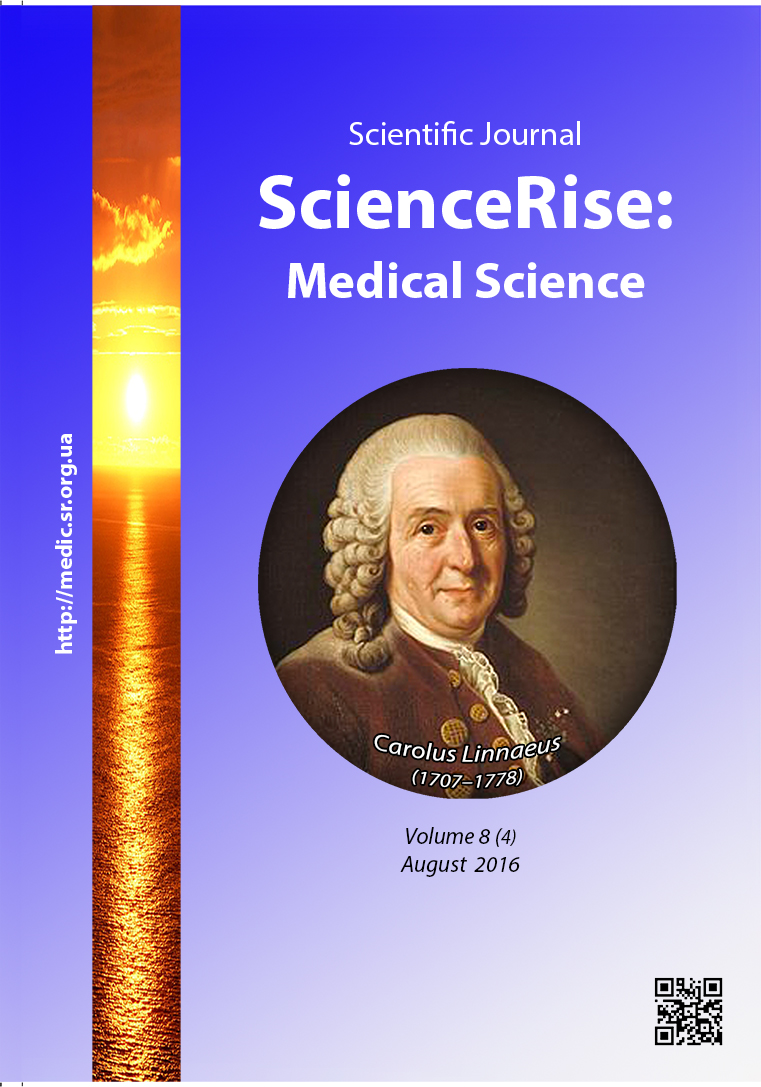Analysis of hemostasis parameters at preeclampsia of the various severity
DOI:
https://doi.org/10.15587/2519-4798.2016.76543Keywords:
preeclampsia, severity degree, risk factors, parameters of hemostasis system, genetic polymorphismAbstract
Preeclampsia it is a serious complication of pregnancy that is a main cause of maternal perinatal morbidity and lethality. In multifactorial genesis of development of this state the main role is played by homeostasis disturbance.
Aim of research: to assess the parameters of hemostasis system in pregnant with preeclampsia of the different severity using the risk factors, genetic polymorphism of folate metabolism genes and blood coagulation.
Material and methods of research. There were examined 155 pregnant women of reproductive age in 3 trimester of pregnancy: 123 – with preeclampsia of the different severity and 32 – with physiological pregnancy course (control). The analysis of risk factors was carried out by the elaborated questionnaire with point assessment. There were studied the genes of folate cycle (MTHFR C677T, MTRR ІІ22Met (66-a-g) and coagulation factors (F5 G1691A, F2 G20210A). There were assessed the parameters of quantity of platelets, fibrinogen level, values of prothrombin index (PTI), international normalized ratio (INR), activated partial thromboplastin time (APTT). The results were processed using the programs of processing of electric tables «Excel 7,0 for Windows XP».
Results. It was established, that the expressed changes (decrease of platelets quantity, increase of fibrinogen level, increase of PTI value, decrease of INR and APTT) were noted in pregnant women that had the high point (≥5) of preeclampsia risk factors, early clinical manifestations of these complication (up to the 34 week of pregnancy), gene polymorphism (heterozygous variant of studied polymorphisms and their complication). There was noted the correspondence between the hemostasis system and severity degree of given complication.
Conclusions. Analysis of values of parameters of hemostasis system in pregnant women with preeclampsia in the third trimester taking into account the risk factors and genetic predisposition has a prognostic value for the assessment of obstetric and perinatal risk and choice of tactics of conducting pregnancy and delivery
References
- Steegers, E. A., von Dadelszen, P., Duvekot, J. J., Pijnenborg, R. (2010). Pre-eclampsia. The Lancet, 376 (9741), 631–644. doi: 10.1016/s0140-6736(10)60279-6
- Duley, L. (2009). The Global Impact of Pre-eclampsia and Eclampsia. Seminars in Perinatology, 33 (3), 130–137. doi: 10.1053/j.semperi.2009.02.010
- Carty, D. M., Delles, C., Dominiczak, A. F. (2010). Preeclampsia and future maternal health. Journal of Hypertension, 28 (7), 1349–1355. doi: 10.1097/hjh.0b013e32833a39d0
- Loskutova, Т. О. (2015). Determination of preeclamsia risk caused by thrombophilia. Experimental and Clinical Medicine, 1, 143–147.
- Kirpichnikova, K. P., Saleh, O. M., Davidovich, D. V. (2014). The place of spinal anesthesia in combination of prevention of thrombotic complications in patients with severe preeclampsia. Clinical anesthesiology and intensive care, 2, 75–82.
- Yerzhan, Z. E., Raeva, G. N., Sagatbekova et. al. (2013). Severe preeclampsia is an actual problem of modern obstetrics. Journal of KazNMU, 4 (1), 33–35.
- Ailamazyan, E. K., Mozgovaya, E. V. (2008). Gestosis: Theory and Practice. Moscow: MEDpress-Inform, 272.
- Makatsaria, A. D. (Ed.) (2011). Trombohemorrhagic complications in obstetric practice. Moscow: Med inform agency LTD, 1056.
- Zaynulina, M. S. (2013). Ways of maternal and perinatal mortality reduction in hemostasis disorders. Medical academic journal, 13 (1), 73–82.
- On approval of clinical protocols on obstetrical and gynecological care: Order No. 676 of 31.12.2004. (2004). MOH Ukraine. Kyiv.
Downloads
Published
How to Cite
Issue
Section
License
Copyright (c) 2016 Бен Амор Мариам, Елена Петровна Гнатко, Елена Игоревна Турос, Нина Владимировна Брезицкая

This work is licensed under a Creative Commons Attribution 4.0 International License.
Our journal abides by the Creative Commons CC BY copyright rights and permissions for open access journals.
Authors, who are published in this journal, agree to the following conditions:
1. The authors reserve the right to authorship of the work and pass the first publication right of this work to the journal under the terms of a Creative Commons CC BY, which allows others to freely distribute the published research with the obligatory reference to the authors of the original work and the first publication of the work in this journal.
2. The authors have the right to conclude separate supplement agreements that relate to non-exclusive work distribution in the form in which it has been published by the journal (for example, to upload the work to the online storage of the journal or publish it as part of a monograph), provided that the reference to the first publication of the work in this journal is included.









